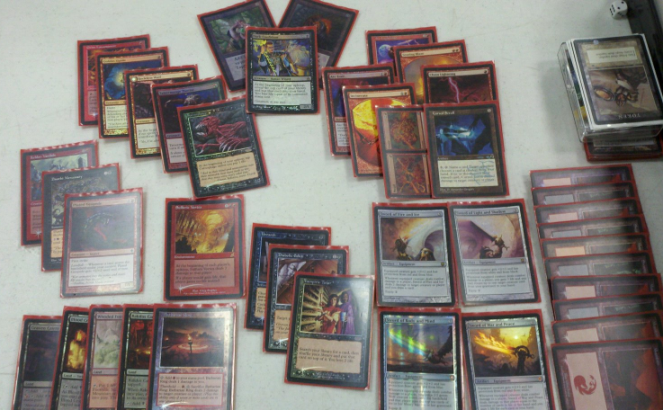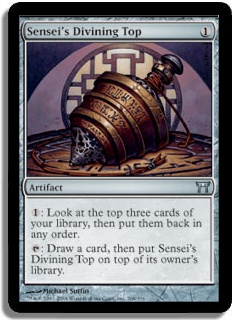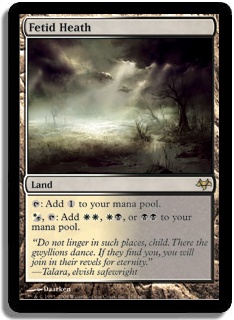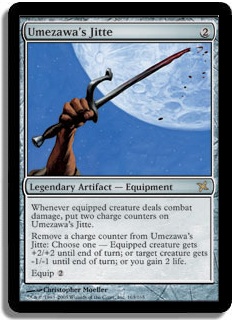Despite what this column has thus far led you to believe, my favorite thing about a cube isn’t its beautiful features; I don’t want to admire it from a distance. Nor is it its brain and how it is so intelligently put together. What I want most from a cube isn’t the discussion it garners from friends and colleagues. No, my favorite part of a cube is much more primal in nature.
I want to touch it. All over. Again, and again, and again.
You know what gets me excited? It’s not finding a Beta Mind Twist. It’s getting passed Mind Twist.
It’s not talking about Planeswalkers. It’s opening Venser, the Sojourner in pack three after I spent the first two packs snapping up all the blue, green, and white enters-the-battlefield creatures I could find.
It’s not discussing how to set up your cube for archetypes to be drafted. It’s about complaining in a draft about how you are terrified of all these red cards going around, only to be drafting the mono-red deck with a curve that stops at three.
It’s not spending money pimping your cube. It’s using your cube to take the same person’s money over and over and over again since they refuse to be on your team.
These things, ladies and gentlemen, are how cubes excite me.
In the cube community, there is so much emphasis on cube construction, theory, and card choices. All of these things are super important, and I don’t want to discount any of that. In fact, up until this point, pretty much all of my content here on SCG has been about such subjects. For cube owners like me, these are important topics. Cube owners know how much work goes into keep a cube balanced, fun, and unique.
That being said, all cube owners first put together a cube because they drafted someone’s cube first and had an absolute blast doing it. Let’s return to those roots.
Before I dive in to the strategy portion, let me talk about myself a tiny bit. I have never played on the Pro Tour, although I have been close on several occasions. I’ve never Day 2ed any of the four Grand Prix I’ve played in and only have a handful of SCG Open top 16s, with nothing better. I’ve been told by players far better than myself that my play skill exceeds my tournament finishes, for whatever that’s worth. I am far, far better in Limited than Constructed, and better in a cube draft than any kind of regular Limited environment, especially in a team format. I promise you that I am someone you (almost) always want on your team. Also my s#!t talking ability far exceeds any kind of Magical ability, and when you’re in a team environment, you can get a lot of mileage out of that.
So now that you know who you’re getting ready to hear strategy advice from, let’s get this party started. Pants stay on though. (For now.)
Today I want to talk about a couple different cards/groups of cards, why they’re overrated or underrated, and where I think they should be drafted respectively. Now since cubes are so unique, I’m going to stick to cards that will be in most standard powered/unpowered cubes for maximum reach.
Sensei’s Divining Top
Oh, Top. You are so misunderstood. And when I say misunderstood, I mean you are valued way too highly by most people. Before I give my opinion, let’s look at the facts:
1) Top is colorless, therefore can be cast by every deck.
2) If drafted, Top will be almost universally included in every deck.
3) By sacrificing a single card and one or two mana per turn, Top can find you the best cards in your deck.
You’re all nodding your head and thinking, “but Parnell, these are all the reasons Top is awesome!”
Not so fast. If we dig a little deeper, we find caveats to all of these facts. And when it comes to Sensei’s Divining Top, you’ll see it’s all about the caveats.
A successful cube draft is all about something I like to call comparative drafting. Comparative drafting is when a value of a card changes based on other cards that could be picked in place of it. Now you’re saying “you moron, that’s just called drafting!” The one, functional difference between a draft with actual booster packs and a cube is there is guaranteed to be one—and only one—of each card available to all players. Each card you pass has a chance to never make your deck. If you take that Mana Drain over that Umezawa’s Jitte, the next time you see that Jitte it will be on the other side of the table (or in the graveyard after you counter it with Mana Drain if you’re lucky). One Fireblast. One Reveillark. One Sensei’s Divining Top.
Since a cube draft is a constant exercise in comparative drafting, we have to first look at what you are going to be passing to take Top. The simple question to ask when comparing a card versus Top is “does this card actively make my deck better?” If the answer to that question is “Yes, this card actively makes my deck better than Top would,” the choice is simple. Of course, the answer is never simple. Do you have fetchlands? Top is slightly more valuable. Do you have an aggressive deck? Top is less valuable. Do you have Dark Confidant? More value. Lots of card draw? Less value.
This comparison seems absurd since we are talking about forty-card decks, and you want to find your best cards. Why don’t we look at a couple of examples of comparative drafting involving Top?
Let’s say you’re in pack three, around fourth or fifth pick. You’ve so far drafted towards blue-black control, and you need a recurable source of card advantage. Top comes around and seems to fit the bill. Then you see Staff of Domination and Sphinx of Jwar Isle. You have no way to end the game other than a Wake Thrasher and Mulldrifter beats. Do you take Top? It gets you to your finisher, whatever you end of picking up the remainder of the draft. But by passing the other two cards, you’re almost ensuring that you lose the chance to have either unique effect.
Next draft, you’re in pack one and have already drafted Garruk Relentless, Lightning Bolt, and Tarmogoyf. Pick four comes around, and you are faced with Bloodbraid Elf and Top as the two clear choices. You’re certainly not going to see BBE’s effect anywhere else, and it’s highly unlikely that it’ll be making the wheel. Top is also unique outside of a possible later Sylvan Library. Taking Top this early allows you to build around it (to an extent), but passing up that cascading haster…
My argument against Top in all of these situations is this: every card you take over Top before your eighth pick should make your deck better, and Top usually doesn’t replace the value of the card you are taking over it in the first half of any pack. The following is an excerpt from a conversation between myself and others on Facebook earlier this year on this subject:
Lucas: Top is not good with card draw. Card draw is good with card draw. Top is good at pretending like its doing something
Andrew: I think the point is that bothering to assemble Top + Arena isn’t doing anything that Arena by itself doesn’t.
Jarvis: the only exception to top is top + future sight is pretty gross.
Anthony: Don’t forget Top + Bob.
Justin Parnell: I feel like Top is often a superfluous card in most decks; its only ever as good as your deck as a whole. It’s not a bad card, but I never never ever want to draft it as highly as the general cube populous thinks it should go (though I think most groups are coming around.) I would be thrilled to have it as a tenth pick, but anytime you’re picking it 1-5, you’re usually sacrificing what would be a better card in your deck or something necessary to your archetype to get some late game value. If you’re cube usually features 6-7/8 drafters playing some kind of midrange-y, no curve deck, then Top would be king.
Matt: I definitely think top is a little overrated, but it’s by no means bad. I agree with Justin’s sentiments. I mostly don’t like Top because it’s a ho-hum pick. It usually gets taken higher than it should, and doesn’t add much depth to your deck or strategy. I cut Library of Alexandria for this reason, though it’s a much more powerful card. Having such big effects than can be used in virtually any deck doesn’t lend itself well to a good draft environment.
Luis: do people not draft decks that do things in most cubes? Top really isn’t good if everyone is drafting decks that do stuff, and without shuffle effects its stone unplayable (barring combos with Bob/Future Sight/Tinker etc). We don’t even have it in our cube, and it wouldn’t be good in or against most of the decks.
Glenn: Virtually every deck I play is some 4 or 5c control deck and i take fetches higher than most of the cards on this list, for whatever that’s worth 😉
Luis: Glenn, yeah those are the decks its best in for sure, but most people seem to jam it in everywhere
Reuben: top is also good in the more combo-y decks, where you are digging for a specific card or two (tooth and nail, cabal coffers, etc.). it doesn’t go everywhere, but in the right decks it’s very good.
Justin Parnell: @Reuben Agreed, but even in those decks its still often far worse than a card you would be picking over it that is integral to the combo itself. You have to pick it so highly that the only time its right in that situation is if your passing a card that SHOULD come back/no one else wants
Between all of our opinions, you should have a pretty good idea on how to evaluate this card. Then again, there are some things that you just can’t argue against.
Reuben: top makes average decks good and above average decks insane. top can go in every type of deck and probably makes it better. top smooths your draws and makes below average hands keepable. top is nigh impossible to kill. top is magical.
however, in the land of first picks it is not the best choice. but it’s still good.
Justin Parnell: Reuben I would argue if you didnt make that post sound like a beautiful poem. So instead I will simply disagree.
Luis: I have to admit, that post is very poetic
Rugged Prairie, Fetid Heath and Friends
Filter lands are some of the most incorrectly valued lands in all of cube drafting. Mana fixing is supremely undervalued by most novice drafters, and I feel like Graven Cairns and its ilk are the worst offenders (or offend-ees in this case).
I had a newer cube drafter talking with another drafter pre-draft a couple of weeks ago. He mentioned to the other drafter to never take lands highly, since you are always passing cards that do stuff. I jumped in as quickly as I could to let him know that I draft my manabase as high as I can and routinely first pick lands out of average packs. He seemed shocked but came around during the draft as I drafted all of my lands face-up, including a pack two pick one Blood Crypt.
It took me some time myself to come around to their usefulness, but let me tell you, these little guys are all-stars. They make back-grated mana base stretches less painful like all multicolored lands, but the fact that they usually allow you to jump from zero of a colored source to double of it gives them a uniqueness that even the original dual lands cannot replicate.
What other card lets you seamlessly curve from Thoughtseize to Soltari Priest to Nantuko Shade + Sacromancy? Only Fetid Heath. What cards let your UR control deck lay down a surprise Nicol Bolas, Planeswalker on turn eight? Sunken Ruins and Graven Cairns. Allow me to show you the list of non-powered cards I will take over Rugged Prairie in a RW aggro deck:
In most cases, that’s about it. I’m not saying to draft fifteen lands and then find your twenty-three spells, but drafting lands enables your deck to reach its potential more consistently. This is more important in a cube format since you are usually playing at least three matches with your deck, giving it more opportunities to either disappoint you by not being able to cast your spells on time or (hopefully) purr like a beautiful engine round after round.
So where should you pick these lands? If you’re in WR, WB, or UR, these lands have much higher upside, as the mana cost of spells is often more intensive than other colors. Even still, I would draft them anywhere from third to sixth, really just taking game breaking cards over them most of the time. Comparative drafting is tougher when comparing lands and spells sometimes, as you can have—and want—redundancy in your mana base.
I’ll be the first to admit that I love lands and am a very greedy drafter color wise. Not Ali Aintrazi greedy, who never saw a five-color deck he didn’t want to kidnap and make sweet love to, but pretty greedy. I draft lands higher than most, and in turn value these lands higher than most. Do yourself a favor and change your thinking on these under-used gems.
That’s all the draft talk for today; if this type of article is popular I will certainly do more in future. I’m still feeling around for a recurring theme that people like, so hit the forums and let your voice be heard. At the least, weigh in on the value of Sensei’s Divining Top and the filter lands!
Before I go, I wanted to touch on the custom cube that Ali Aintrazi and I are building. By the time of this article being published, all five of the “power cards” will have been spoiled and talked about quite a bit in the comments of his articles. If Cubers Anonymous readers would like to see some previews of other cards/mechanics, let me know, and I will do a little spoiling of my own at the end of future articles. We still have a ways to go before we are comfortable releasing the full 360-card list to the public but don’t mind showing off some things that we are sure on at this point.
Here’s a random picture of a deck I drafted in the last month:

I call this deck: “Spells featuring turn two Bob (pants included.)”
Thanks for reading and be sure to head over to facebook.com/mtgcubedrafting to hear about current Rotisserie drafts played at StarCityGames.com Opens, take part in polls, and more.




